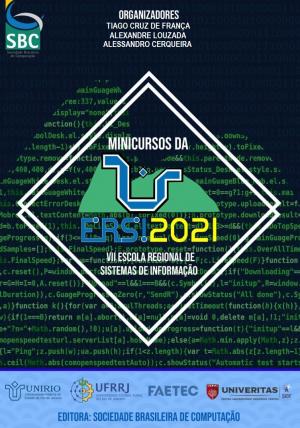Minicursos da ERSI-RJ 2021 - VII Escola Regional de Sistemas de Informação do Rio de Janeiro
Palavras-chave:
ERSI-RJ, Sistemas de InformaçãoSinopse
A Escola Regional de Sistemas de Informação do estado do Rio de Janeiro (ERSI-RJ) é um evento que reúne profissionais, professores e estudantes interessados em aprender e discutir problemas, soluções e conceitos relacionados a Sistemas de Informação. Os minicursos são atividades de curta duração (quatro horas) que fazem parte da programação da ERSI-RJ. Eles abordam temas relacionados a Sistemas de Informação com objetivo de proporcionar ao público da escola um ambiente de aprendizagem e de discussão de tendências e desafios na área de Sistemas de Informação. É o primeiro ano da escola após a pandemia do novo coronavírus que levou ao cancelamento do evento em 2020. Este ano (2021), foram selecionados seis minicursos entre as propostas recebidas. Além desses, mais duas propostas foram aceitas para serem publicadas como capítulos deste livro. A seleção foi realizada por um comitê de avaliadores. Todos professores e profissionais de Sistemas de Informação. Os critérios de seleção das propostas foram: relevância para o evento, expectativa de público, atualidade e conteúdo. Os capítulos deste livro abordam: os conceitos e formas de detecção das fake news nos meios digitais de divulgação de notícias; uma linguagem de modelagem organizacional que trata o tema de estratégia e alinhamento de recursos humanos baseado em competências; o uso de linguagem simples como suporte à transparência e ao desenvolvimento das melhores práticas para transformação digital; o gerenciamento de dados praticado no âmbito do jornalismo de dados; a introdução a projetos de jogos com fins educacionais que inclui um canvas destinado ao Design de Jogos Educacionais Endógenos, o qual integra conteúdos e regras; os conceitos, definições, aplicações e pesquisa de Ética em Sistemas de Informação; os principais protocolos da camada de aplicação da Internet das Coisas (do inglês, Internet of Things) com uma ênfase prática nos protocolos CoAP e MQTT; e um exemplo de aplicação da linguagem R em bases de dados sobre COVID-19 e transporte público na cidade do Rio de Janeiro correlacionando os dados, reduzindo tendências e sazonalidades. Acreditamos que este material será útil em aulas de Sistemas de Informação; em discussões sobre novas abordagens de pesquisa suportando trabalhos atuais e futuros; e para apoiar a prática profissional. Parabenizamos e agradecemos aos autores dos capítulos. Agradecemos também ao Comitê de Seleção de Propostas pela dedicação e eficiência; ao Comitê Editorial pelo empenho; e a CESI (Comissão Especial de Sistemas de Informação) da SBC (Sociedade Brasileira de Computação) pelo apoio para publicação deste livro. Por fim, agradecemos ao aluno da graduação em Sistemas de Informação da Universidade Federal Rural do Rio de Janeiro Matheus Nunes Ritton pela capa do livro. Este é a sua segunda colaboração com as capas do livros de minicurso da ERSI-RJ.
Capítulos
-
1. Combate Automático às Fake News nos Meios Digitais
-
2. Modelagem da Estratégia e Alinhamento de Recursos Humanos Baseado em Competências
-
3. Transparência e Transformação Digital: O Uso da Técnica da Linguagem Simples
-
4. Técnicas e práticas de jornalismo de dados para aquisição e gerenciamento de dados em MySQL aplicadas ao domínio da violência contra a mulher
-
5. ENDO-GDC: Projetando Jogos Educacionais
-
6. Pensando-fazendo Sistemas de Informação com Ética. Da pesquisa à engenharia, e vice-versa.
-
7. Desvendando a Camada de Aplicação na Internet das Coisas: Teoria, Prática e Tendências
-
8. A linguagem R na análise de dados: Um estudo de caso dos transportes públicos do RJ durante a pandemia da Covid-19
Downloads

Downloads
Data de publicação
Categorias
Licença

Este trabalho está licenciado sob uma licença Creative Commons Attribution-NonCommercial 4.0 International License.


